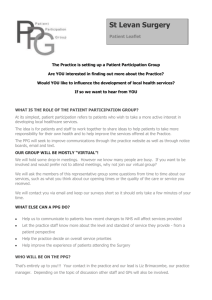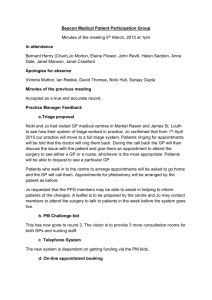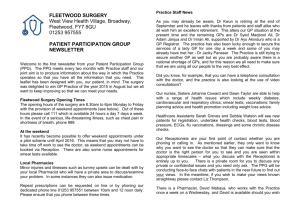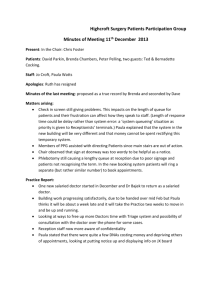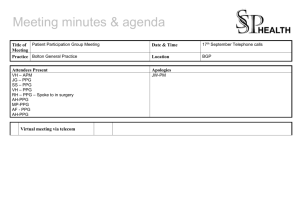Development of Patient Participation Direct Enhanced Service
advertisement
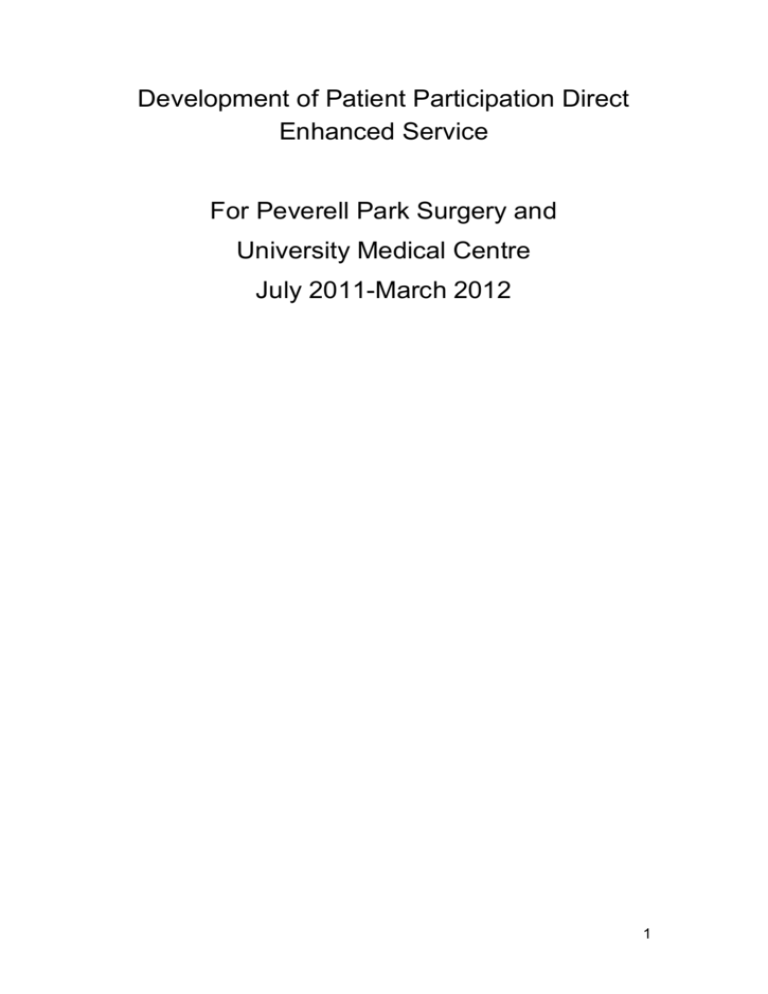
Development of Patient Participation Direct Enhanced Service For Peverell Park Surgery and University Medical Centre July 2011-March 2012 1 Contents 1.1 Executive summary 5 1.2 Introduction 6 1.3 Present situation 7 1.3.1 Problems associated with present situation 7 1.3.2 Teenagers/students 7 1.3.3 Elderly groups 7 1.3.4 Ethnic groups 8 1.3.5 Disability groups 8 1.4 Findings 9 1.5 solutions/proposals 9 ` 1.5.1 Teenagers/students 9 1.5.1.1 Facebook 9 1.5.1.2 Fresher fayre 9 1.5.1.3 SurveyMonkey 9 1.5.2 Elderly groups 9 1.5.2.1 nursing/residential homes 9 1.5.3 Ethnic groups 9 1.5.4 Disability groups 10 1.5.5 Use of practice newsletter 10 1.5.6 Use of Facebook and website 10 1.5.7 Extended hours and opening times 10 1.6 Success of widening group participation 10 1.6.1 Teenagers/students 10 1.6.2 Elderly groups 11 1.6.3 Ethic groups 11 1.6.4 Disability groups 11 2. Survey areas of priority with the PPG and vPRG 2.1 Meeting with PPG 11 11 2 2.1.2 SurveyMonkey 11 2.1.3 Newsletter 11 2.2 Findings of PPG survey 12 2.3 Agreed areas of priority 12 3. Agreed action plan 13 4. Review 13 3 Appendices Appendix a - Plymstats 2010 Appendix b - Implementation plan Appendix c - Facebook page Appendix d - patient participation survey Appendix e- SurveyMonkey results Appendix f – Newsletters (new style) Appendix g – Action plan References Department of Health Patient Participation Group Direct Enhanced Service 2011/12 Emis search 2011- in house computer system www.plymstatbrf.24May2010 Official national statistics 2001 Cencus www.dcca.info 4 1.1 Executive summary Peverell Park Surgery (PPS) and the University Medical Centre (UMC) plan to participate in the Patient Participation Group Direct Enhanced Service (PPG DES). To do this communication to all patients will need to be improved, this will enable a Patient Participation Group (PPG) and a Virtual Reference Group (vPRG) to be established. PPS and UMC plan to do this by targeting four main groups of patients to complete step one of PPG DES. Target groups will be teenagers/students, elderly, ethnic minority and disability groups. PPS and UMC plan to use various forms of communication such as Facebook, emails and letter drops. Barriers to communication have been identified as under use of technology, cultural and language barriers, alongside physical disability barriers and location barriers of a branch surgery. An implementation plan has been produced that will enable the set up of a pro-active the PPG and a vPRG. Implementation plan will allow completion of step one to be finalised by the end of October 2011, with review March 2012. Resources needed include setting up of Facebook page, use of survey monkey, mail drops, email and man-power of PPG (existing focus group). 5 1.2 Introduction The Department of Health (DOH) has introduced a Patient Participation Direct Enhanced Service for General Medical Services. Key objectives are “The purpose of the PPG DES (Patient Participation Group Direct Enhanced Service) is to ensure that patients are involved in decisions about the range and quality of services provided and over time, commissioned by their practice…..” The purpose of this report is to show how PPS plans to adapt a very successful ‘focus group’ into a pro-active Patient Participation Group that involves a cross section of patient’s views across a diverse, large patient group. The main focus of the Patient Participation DES is to enable patients to have a better communication format to express their views and help structure the services provided by the local health care provider. For the purpose of this report we have reviewed step one- six of the PPG DES, the key stakeholders will include teenagers, the elderly, ethnic groups and disability groups. This cross section of key stakeholders is not a full representation of our patient list, however for this 1st stage the ‘focus group’ recognised that the four targeted areas are probably the least represented. We plan to introduce a further stage which will cover new mothers, working men and women and healthy nonattenders. 6 1.3 Present structure The present structure is that PPS has a very well attended focus group. The focus group meets once every quarter and has helped PPS over many years by providing feedback on proposed changes, man power with survey completion and projects such as flu campaigns. Whilst this group has always been beneficial and PPS have always appreciated the on-going support of the group, the DOH proposed outline of the new Patient Participation Group (PPG) will be more inclusive to all patients and include a wider cross section of patients. Currently the group is largely made up of retired or semi-retired individuals. Communication to patients is primarily conducted through a wellreceived newsletter that is published once a quarter. 45% of the practice profile is made up of 18-23 year olds at the surgery’s branch site the UMC. 1.3.1 Problems associated with present situation For the purpose of this report we will look at the problems associated with the present situation in regards to communication for four groups; these four groups have been identified as being under represented by the current PPG group. 1.3.2 Teenagers/students The barriers to communication to teenagers/students currently are lack of up to date technology. Teenagers and students are computer literature and tend to favour technical communication methods such as Facebook, text messaging and emails. Currently the practice does not practise regular text messaging or emails. Teenagers/ students have busy hectic lives, juggling school, college/university with social lives, part time jobs and often moving away from home for the first time. PPS has an additional barrier to communication in that the majority of teenagers/students are seen at the University Medical Centre (UMC) branch site. This is a relatively small surgery that houses two Practices; there is little wall space to be able to promote any form of health promotion or encourage communication and participation from students. 1.3.3 Elderly groups PPS main branch has a patient list made up of 32% of patients over the age of 75. 1.5% of over 75 year olds reside in a residential/nursing home or are classed as housebound (Emis search 2011-in house computer system).The barriers to communication to these patients are that a majority will not have access to the internet or have the technical ‘know how’ for social networking such as Facebook or Twitter. Due to being in a nursing/residential home or being housebound patients rarely visit the surgery, all communication is conducted through letters or GP visits. 7 1.3.4 Ethnic groups As of 2001 Ethnicity in Plymouth was below national average. Up to date figures are not available. “1.6 % Plymouth had a small proportion of people from ethnic minority than the region as a whole or England 2001 (2.3% and 9.1%)” www.plymstatbrf.24May2010 GOSW Regional Intelligence Team (appendix aplymstats 2010) The largest ethnic population of Plymouth is Chinese. The area of Peverell Plymouth houses 14% of the total Chinese population of Plymouth. (Source: office for National Statistics 2001 census). The Chinese population are recognised as being low users of the NHS; it is thought this is mainly due to their own beliefs and use of non-Western medication. Language and cultural barriers make it difficult to engage Chinese elders. 1.3.5 Disability Groups Disability Groups can come under many categories; barriers to communication can be physical or mental disabilities. Patients with a sight, hearing or speech impediment may struggle with the usual day to day forms of communication used such as letters and questionnaires. Physical disabilities may mean that a patient rarely attends the surgery; so has little contact with health professionals and services that the Practice promotes. Mental health disabilities can mean that patients who fall into this category have little say on how they would like to see their services run. PPS has good disability access to the premises on the ground floor and participates in the ‘hearing loop’ scheme, alongside regular use of deaf interpreters. However little consideration is given to patients with a sight impediment. Current focus group meetings are conduct in the upstairs meeting room without disabled access. 1.4 Findings It is clear to see that to enable PPS and the UMC to partake in the PPG DES the current focus group will need to be expanded and a wider selection of views from patients canvassed; creating a Patient Reference Group (PRG) and Virtual Patient Participation Group vPPG. Consideration needs to be given to the 455 of patients between the ages of 18-23 years who attend our branch site the UMC. 8 1.5 Solutions/proposals 1.5.1 Teenagers/students To reach teenagers/students we have looked at our use of technology. We currently under use the information technology we have. Feedback from our current focus group suggested the use of a more structured IT approach. We plan to do this via several different methods. (Appendix b- implementation plan to establish PPG and vPRG) 1.5.1.1 Facebook: We plan to set up a Facebook page for the UMC to reach students and a Facebook page for PPS. Up dated information can be placed on a Facebook page offering students and teenagers the ability to take part in on-line questionnaires. First stage implemented: www.facebook.com; University Medical Centre (PPS) (Appendix c- Facebook page). 1.5.1.2 Freshers Fayre: Fresher’s week at the start of September gives the surgery an ideal opportunity to start engaging students. We will seek permission to use email addresses and text messaging, inviting students to join a vPRG (virtual Patient Reference Group) or the traditional PPG. Meetings can be held at the UMC if required. The UMC website has been widely advertised on all forms of communication to fresher students, including a leaflet published and placed in prospectuses for the University of Plymouth (UoP). Contact has been made with the UoP student body who plan to include a 90 minute video clip of the UMC informing students of services and how to get involved with vPRG. 1.5.1.3 Survey monkey: With the help of the PPG we would like to establish a vPRG that will cover a cross-section of students and teenagers. The aim is to use such tools as survey monkey to canvas opinions. 1.5.2 Elderly Groups: To enable PPS to gain a cross-section of views; the views of the elderly will need to be canvassed; it is planned to do this via: 1.5.2.1 Nursing/residential homes: With the help of the PPG we would like to contact the four main nursing/residential homes and seek permission to visit and discuss issues/views on a one to one basis with patients in residence. 1.5.3 Ethnic minority groups: PPS would like to concentrate on engaging the Chinese population during the first stage of implementation. The Chinese population are known to be private and reserved; with that in mind we would ask that the PPG make contact with Devon and Cornwall Chinese Association; www.dcca.info in the first instance to seek opinion of best approach. 1.5.4 Disability Groups: To enable initial contact a mail drop will be conducted with an invitation to join the vPRG or PPG. Invitations will include a 9 choice of preference on how to be conducted i.e. via email or letter. For those who have been identified with a sight impediment we would need to seek advice from Plymouth Primary Care Trust on how best to reach this group. It is planned that implementation of the first stage will be conducted by the End of October. (Appendix b – implementation plan). 1.5.5 Use of Practice newsletter: The surgery has an established newsletter that is issued quarterly. A review of the newsletter has identified that: 1. newsletter needs to include opening hours and any planned closures, including extended hours. The Practice have not always made available what health professional is accessible until now, but plans are to include this information on all literature in future. At all extended hour sessions a GP and a nurse is available. 2. information on how to join the vPPG or PPG 3. option to allow patients to feedback views via email or in writing 4. information on any changes made to the surgery 1.5.6 Use of Facebook and website As with issues identified above the practices’ website and Facebook accounts would include all points in 1.5.5. 1.5.7 Extended hours and opening hours The Practice uses it’s Facebook page and website to advertise opening hours and extended hours available, these are also advertised in the surgery. The PPG identified the need to advertise extended hours and opening times on the newsletter in a more informative layout, new format have been added to the last newsletter but further work needs to be put in place to ensure that all extended hours options are advertised in advance. 1.6 Success of widening group participation: 1.6.1 Teenagers/students The use of Facebook and the website have proven to be very successful for teenagers and students. The UMC Facebook account has 34 members for its vPRG. 10 1.6.2 Elderly Groups; First contact with this patient group has not been very successful with no up take. A decision was made to wait until the ‘flu’ campaign to contact this group of patients again, it was felt that it would be a better use of resources to include a sentence or two on the annual flu letters sent out. This is planned for September 2012. It was also felt that Sister Tracey Allen might be more successful engaging with this group of patients when she did her housebound visits to patients. 1.6.3 Ethnic Minority group: Members of the PPG approached the local community of Chinese residents through Hope Baptist Church, the community expressed no interest in joining at present. It was suggested that the surgery promote the PPG through surgery publications and await contact from interested parties. 1.6.4 Disability groups: PPS have 21 friends through Facebook , PPS continue to promote it’s website and Facebook page. 2. surveying areas of priority with the PRG and vPRG and patients. 2.1Meeting with PPG: A meeting was held with the current PPG to discuss how opinion for areas of priority for the PPG could be attained. A patient participation survey was produced for both the UMC and PPS. Appendix d- patient participation survey. Three questions were asked to 100 patients: 1. What do you think are the most important issues on which we should consult our patients? 2.If we were able to offer more appointments what type of appointments would you like more of? 3. What type of things would improve the ‘patient experience’? 2.1.2 Survey monkey A survey monkey questionnaire was placed on the UMC Facebook account to canvas opinion from students. 2.1.3 Newsletter 11 The PPG newsletter has had a regular news feature on how to join the PPG and vPRG and details on the aims of the PPG. Patients are invited to contact the surgery and feedback or join the vPPG. The news letter is published on the website for the UMC and PPS, and is also published on the UMC’s and PPS’s Facebook page. Newsletters are printed and placed in reception areas of both surgeries. 2.2 Findings of patient participation survey: Peverell Park Surgery and the University Medical Centre Importance of issues patients wanted to be consulted on: 41% clinical care 41% getting an appointment 18% patient experience. Appointments : % of patients questioned said they would like to see more appointments in: 17% minor surgery appointments 36% routine 12% chronic disease 15% emergency appointments Feedback: what things would improve the ‘patient experience’ Patients asked for: 1. Reception staff to wear name badges 2. Recycling bin for old batteries for such things as hearing aids. 3. More notice for minor surgery appointments, giving two weeks whenever possible 4. More appointments available. 2.3 Agreed areas of priority. Having reviewed the findings of the patient survey and the results of the SurveryMonkey questionnaire- appendix -e- SurveyMonkey results with the GPs at the surgery and the PPG the agreed areas of priority were: 12 1. more appointments for all types of consultations 2. prioritise the ‘patient experience’ requests ie name badges and recycling bins. 3. Agreed action plan A Partnership decision was made to recruit more clinical staff. The Partners have committed to recruiting an additional Nurse Practitioner and a practice nurse to improve the amount of appointments available to patients at the UMC and PPS. Further actions include the purchase of recycling boxes for both surgeries, name badges being provided for reception staff and a change tp GP rota to establish a new structure to include more opportunity for minor surgery appointments. These decisions have been communicated through the surgery’s newsletter Appendix f- Newsletter 1,2,3 and publication through the surgery’s website and Facebook pages, newsletters are also available in both reception areas. A copy of this report is available in both reception areas and has been uploaded to the surgery’s website. Appendic g- action plan for implementation of areas of priority. 4.Review PPS and the UMC plan to review areas of implementation at the end of May 2012. A continued campaign of recruitment to the PPG and vPRG will remain in place through, literature, Facebook and websites. The current newsletter letter will be adapted / amended to include further information reference surgery changes and services offered, including extended hours. 13 Appendix to follow on hard copy 14
